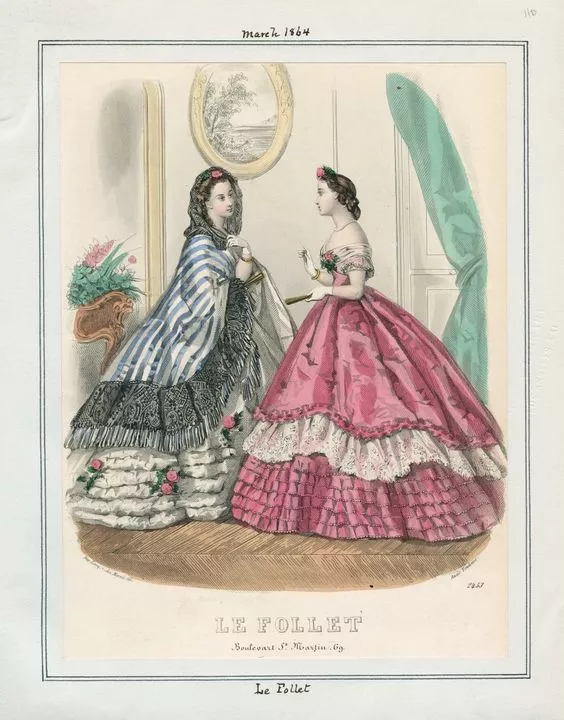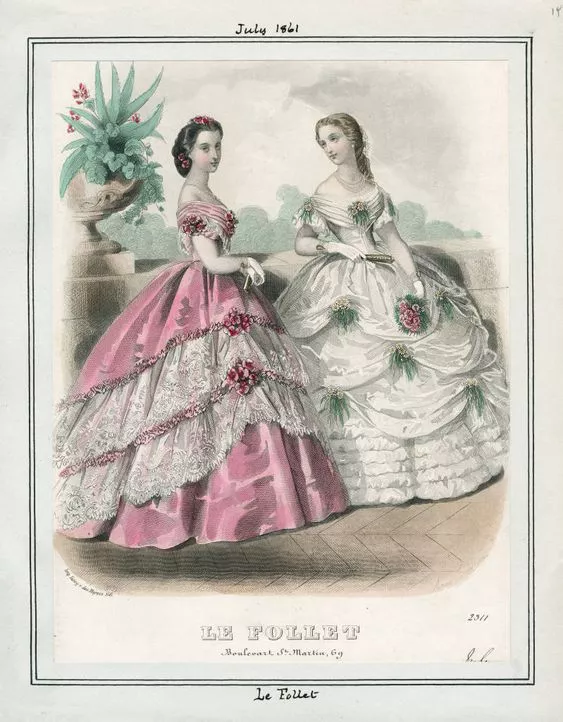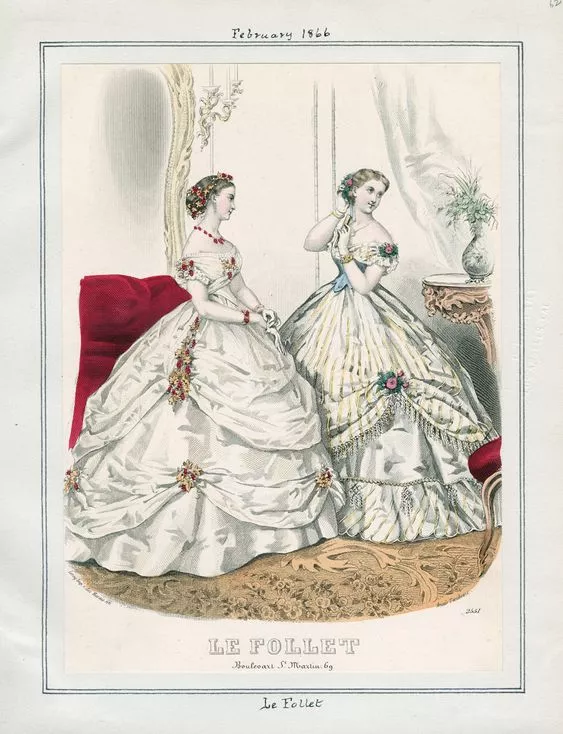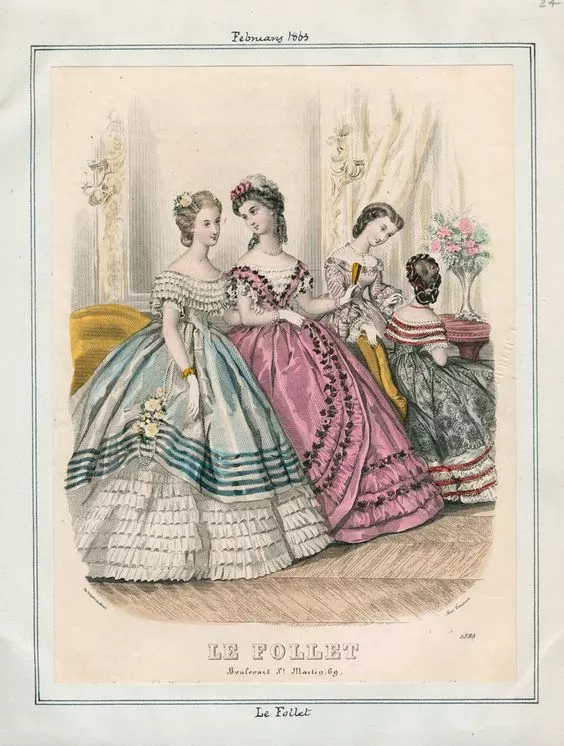Pri slávnostnej príležitosti získania piatej hviezdy, hostí HOTEL LOMNICA unikátne modely historických šiat z obdobia renesancie, baroka a „zlatého veku“ druhej polovice 19. storočia. Ide o reprezentatívne dvorské róby aristokratiek, súčasťou ktorých je aj prezentácia verných replík dobových dekoratívnych šperkov z drahokamov a polodrahokamov a korunovačných klenotov. Súčasťou výstavy sú najikonickejšie šaty cisárovnej Alžbety Bavorskej, známej ako Sissi, ktoré nájdete pred vstupom do Kaviarne Mozart.
Výstava dobových šiat trvá v priestoroch hotela od 17.12.2022 do 8.1.2023.
Pozrite si prehľad jednotlivých modelov pri návšteve hotela:
1. Magdaléna Esterházy (1567 – 1617)

Reprezentačný dvorský komplet mladej aristokratky žijúcej na severe Slovenska je zložený z fialovej zamatovej sukne a vystuženého živôtika rovnakého materiálu. Oba zdobí ručne prišívaná zlatá bortňa. Živôtik je vpredu otvorený, biela batistová košeľa je tak koncipovaná ako spodná aj pohľadová vrstva zároveň. Typický kužeľovitý tvar sukne zabezpečuje špeciálna spodnička (verdugado) so všitými obručami. Odev dopĺňa zástera lemovaná čipkou, symbolický prvok uhorskej módy odkazujúcu na cnosti uhorských dám. Tými boli skromnosť, pracovitosť, bohabojnosť, čo v tomto ojedinelom prípade nositeľku naozaj vystihuje. Najluxusnejším prvkom celého kompletu je vrchná vrstva – fialovo-starozlatý kabát z pretrhávaného zamatu s veľkými štylizovanými rastlinnými motívmi, lemovaný kožušinou čokoládovej farby. Táto luxusná látka pochádza z benátskej dielne, kde tradícia výroby prestížnych tkanín siaha do čias benátskych dóžov (1m = 280 €). Do Benátok a Janova chodili ťažko dostupné látky z Orientu pravidelne nakupovať aj renesanční magnáti, či ich vyslanci.
2. Alžbeta Báthory (1560 – 1614)
Odev všeobecne známej „krvavej grófky“, ale aj vzdelanej renesančnej aristokratky, majiteľky viacerých panstiev na Slovensku, v Maďarsku aj Rakúsku, predstavuje rekonštrukciu opierajúcu sa o jej zachovaný portrét (aktuálne v zbierkach Trenčianskeho múzea – Draškovičova kúria). Komplet tvorí živôtik a sukňa z hodvábneho zamatu hlbokej bordovej farby. Oba odevné prvky sú zdobené kontrastnými vyšívanými bortňami. Charakteristická je strohá uzavretá košeľa z jemného transparentného batistu s objemnými rukávmi a zástera z hodvábnej zmesi. Na vsadkách a leme zástery je použitá pravá paličkovaná „tudorovská čipka“ s tradičným renesančným motívom – dovezená priamo z Anglicka (400 €). Dnes už legendárnou súčasťou odevu dodávajúcou Alžbete sofistikovaný a prísny výraz je plochý límec – rebato. Je šitý zo vzdušnej krajky a podopiera ho kovová konštrukcia. Na vytvorenie takejto konštrukcie sa spotrebovalo 11 m tenkého drôtu, ohýbaného do presného tvaru podľa zachovaných originálnych nálezov z Holandska a Anglicka.
3. Alžbeta Czoborová (1578 – 1626)

Odev Alžbety Czoborovej, panej Oravského hradu, Bytče a Lietavy, je koncipovaný ako ideálny dvorský uhorský komplet mladej ženy žijúcej na severe Slovenska. Keďže sa jej portrét z mladosti nezachoval, k jej povestným svetlým vlasom a modrým očiam boli zvolené odtiene modrej – bledšia je použitá na sukni a živôtiku. Oba kusy odevu sú zdobené prámami zlatej farby z kovových nití. Modrá bola považovaná za kráľovskú farbu a jej odtiene boli veľmi obľúbené aj medzi aristokratmi na našom území. Košeľa a zástera sú šité z jemného batistu s čipkovanými lemami, čipková vsadka sa nachádza aj po celej dĺžke rukávu. Zaujímavým prvkom je tmavomodrý kabát úzkeho strihu siahajúci po zem. Je to takzvaná mentieka, odvodená od pánskej módy, v tomto prípade bez rukávov. Prednú stranu a golier zdobí široký tmavohnedý kožušinový lem. Podšitý je kontrastným damaškom žltozlatej farby s rastlinným ornamentálnym vzorom.
4. Petronela Zmeškalová ( ? – 1600)
Odev Petronely Zmeškalovej, manželky správcu oravského panstva, bol vytvorený podľa jej zachovaného epitafu z r. 1600 (v Brezovici nad Torysou). Už na prvý pohľad zaujme strihom, ktorý sa odlišuje od predchádzajúcich modelov. Nejde totiž o typický uhorský odev, ale obsahuje prvky nemeckej renesančnej módy, ktoré sa prejavujú predovšetkým strihom živôtika. Ten je v prednej časti uzavretý a šnurovanie sa nachádza vzadu. Materiál použitý na veľkoryso riasenú sukňu a živôtik je sivý pretrhávaný zamat s hodvábnym leskom a štylizovaným rastlinným vzorom, oba sú zdobené zlatými prýmkami. Odev dopĺňajú spodné vrstvy – košeľa a zástera lemovaná bavlnenou paličkovanou čipkou. Za cudzí módny vplyv implementovaný do uhorskej módy môžeme považovať aj škrobený naberaný límec – okružie, ktorý je typický pre západné krajiny. Na jeho tvorbu polo použitých 8 m prírodnej bavlny a paličkovanej čipky (rovnakej ako na leme zástery). Celý komplet však dopĺňa uhorský krátky pláštik – takzvaná „malá šuba“ alebo „šubka“. Jej strih je kruhový a keďže je celopodšitá kožušinou, na jej výrobu sa spotrebovali 2 konfekčné dámske kožuchy. Charakteristická pre náš región je aj kožušinová čiapka so zlatou brošňou zdobenou perlami.
5. Anna Rosina Listhiusova (1583 – 1643)

Odev takzvanej „šintavskej bosorky“ či „kráľovnej čarodejníc“ nezostáva nič dlžný jej povesti. Ide o čierny komplet striedmo zdobený zlatými portami. Uhorské prvky zostávajú zachované – viditeľná je biela košeľa a zástera z jemného batistu s čipkovaným lemom. Nádych mystickosti dodáva objemný kabát rozširujúci sa od prieramkov, predĺžený v zadnej časti do krátkej vlečky. Je šitý z čierneho/antracitového pretrhávaného zamatu s typickým renesančným motívom akantových listov. Rukávy lemuje čierna kožušina.
6. Katarína Pálffy (1542 – 1616)
Odev slobodnej pani Jura a Pezinka reprezentuje emancipovanú a sebavedomú aristokratku. Jeho hlavné súčasti, živôtik a bohatá riasená sukňa, sú šité z pretrhávaného zamatu výraznej červenej farby s hodvábnym leskom. Na túto sukňu bolo spotrebovaných najviac metrov látky – jej spodný obvod má až 7 metrov a je zdobený zlatým aplikovaným vyšívaným rastlinným ornamentom v dvoch rôzne hrubých pásoch (výroba trvala 9 mesiacov). Rovnaký motív sa nachádza aj na živôtiku. Tento vzor symbolizuje ušľachtilú vínnu révu, ktorá sa rodila na miernych svahoch malokarpatských viníc a bola zdrojom bohatstva celého rodu. Komplet samozrejme dopĺňa uhorská zástera vyrobená z jemného batistu, zdobená po obvode výraznou čipkou. Vrchnú vrstvu predstavuje veľkoryso strihaný zamatový kabát siahajúci po zem s tvarovaným trupom a úzkymi rukávmi. Zapínanie zabezpečujú gombíky a ozdobné zlaté šnúry stočené do slučiek, čo predstavuje typicky uhorský prvok mužskej až ženskej novovekej módy. Po celej dĺžke je kabát lemovaný sivočiernou kožušinou s dlhým chlpom.
7. Žofia Bosniaková (1609 – 1644)

Odevný komplet „Svätice spod Strečna“ je vytvorený podľa jej portrétu v zbierkach Trenčianskeho múzea. Je tvorený tmavomodrým pretrhávaným zamatom s jemným leskom a menším rastlinným ornamentom. Farebne dominujúcim prvkom je červená ozdobná stuha, pomocou ktorej sa zaväzuje vystužený živôtik. Napriek tomu, že ide o váženú aristokratku, odev nie je zdobený. Luxusný materiál preto ostro kontrastuje s absenciou akýchkoľvek dekoratívnych prvkov, avšak vystihuje vyberanú eleganciu a zároveň skromnosť nositeľky. Je zaujímavé, že Žofia nenosila tradičnú súčasť odevu – dekoratívnu zásteru. Avšak táto žena na svoje cnosti upozorňovať okolie nemusela. Jej dobrota bola známa po celom Uhorsku ešte za jej života. Jednoduchá košeľa s hladkými manžetami riasená do nízkeho límca a zaväzovaná tesne pri krku bola zvolená cielene, aby takmer nič neodhaľovala. Celý odev dopĺňa strohý zamatový plášť modrej farby siahajúci po zem s hlbokou kapucňou, do ktorého sa zvykla zahaliť, aby nepoznaná poskytovala pomoc chudobným a núdznym na jej panstve a v jeho okolí.
8. Mária Széchy / Séči (1610 – 1678)
Odev legendárnej krásavice, „Muránskej Venuše“, je realizovaný podľa jej portrétu. Živôtik a sukňa sú šité z tmavozeleného hodvábneho zamatu s vysokým leskom, oboje sú zdobené hrubou zlatou bortňou v tvare rastlinného pletenca. Zaujímavý je tvar živôtika naznačujúci pozvoľný príchod rokoka – zhustené kontrastné šnurovanie v prednej časti a jeho celkové predĺženie do charakteristického „V“. Tieto zmeny odzrkadľuje aj košeľa odlišného strihu s hlbokým oválnym výstrihom a balónovito aranžovanými rukávmi ozdobenými dekoratívnou mašľou. Výstrih aj rukávy lemuje jemná čipka, rovnako ako obvod transparentnej zásterky. Rukávy košele sú aranžované tak, aby odhaľovali zápästia, a tým pádom dali vyniknúť náramkom. Vrchnú vrstvu celého reprezentatívneho kompletu predstavuje – nezvyčajne – mužský kabát. Mária Séči bola známa svojou odvahou a emancipovanosťou. Hovorí sa, že s mužmi rada chodila na lov, dokonca jazdila v pánskych nohaviciach. Zelený zamatový kabát je typicky mužský so všetkými atribútmi magnátskej uhorskej módy – predná strana je zapínaná pomocou vodorovných ozdobných šnúr (pozamentov), kabát je veľkoryso strihaný do tvaru „A“, zdobený kožušinou.
9. Uršula Esterházy (1641 – 1682)
Najbohatšia uhorská nevesta je prezentovaná pomerne umiernene – v odtieňoch olivovej zelenej so zlatým odleskom. V tejto farebnej kombinácií je často zobrazovaná na zachovaných portrétoch. Odevný komplet tvorí sukňa z hodvábneho zamatu so zdobeným rastlinným lemom v spodnej časti. Ide o čiastkovú rekonštrukciu jej zachovaného odevu, ktorý sa nachádza v zbierke Umeleckopriemyselného múzea v Budapešti. Farba živôtika je tmavšia zelená, jeho prednú aj zadnú časť zdobí ručne prišívaná ozdobná bortňa s geometrickým motívom. Tradičnú sukňu so živôtikom dopĺňa zástera s čipkovaným lemom a jemná biela batistová košeľa. Vrchnú vrstvu predstavuje krátky kruhový uhorský pláštik – šuba (šubka), ktorý je celopodšitý sivou kožušinou a zdobený dvomi líniami prámov zlatožltej farby.
10. Juliana Géczi Korponayová (1680 – 1714)
Legendárna a tragická „Levočská biela pani“ je samozrejme oblečená vo svetlých odtieňoch. Nejde však o čisto bielu – živôtik aj sukňa sú šité z hodvábneho pretrhávaného zamatu vysokého lesku s rastlinným ornamentom v odtieňoch slonovinovej až sivej. Silueta odevu je už výraznejšie rokoková. Vytvára ju enormne bohatá sukňa riasená v páse, predĺžená do 1,5 metrovej vlečky. Živôtik je predĺžený v prednej časti so zhusteným šnurovaním. Hlboko dekoltovanú košeľu lemuje široká benátska čipka. Zámerne aranžované rukávy nechávajú vyniknúť kaskádovito padajúce ozdobné lemy v oblasti predlaktia. Dojem neprístupnosti a melanchólie podčiarkuje dôstojný kabát čistých línií slonovinovej farby, zúžený v trupovej časti, ktorý je lemovaný bielou kožušinou.
On the festive occasion celebrating the achieving of the 5-star rating, HOTEL LOMNICA will put on display highly unique models of historical dresses from the Renaissance and Baroque era as well as from the Belle Epoque dating to the second half of the 19th century. These are representative court robes of noble ladies complete with the presentation of faithful replicas of decorative jewelry from these historical periods made of precious and semi-precious stones as well as replicas of coronation jewels. The exhibition includes the most iconic dress of Austrian Empress, Elizabeth of Bavaria, known as Sissi, which can be seen in front of the entrance to our Mozart Café.
Our exhibition of period dresses will be on display at the hotel from 17 December 2022 to 8 January 2023.
See an overview of the individual models when visiting the hotel:
1. Magdaléna Esterházy (1567 – 1617)

A representative court outfit of a young aristocrat living in the north of Slovakia consists of a purple velvet skirt and a reinforced bodice made of the same material. Both are decorated with a hand-sewn golden trim. The bodice is open at the front: the white batiste shirt is designed as both the bottom layer and simultaneously as the frontally displayed layer. The typical conical shape of the skirt is ensured by a special farthingale called verdugado with sewn-in hoops. The attire is complete with an apron lined with lace, a typical decorative garment of Hungarian noble fashion referring to the virtues of Hungarian ladies. This included modesty, diligence, godliness, which – in this rather unique case – really does justice to the wearer. The most luxurious item of the entire dress is the top layer – a purple-gold jacket made of shredded velvet decorated with large, stylized plant motifs, lined with chocolate-colored fur. This luxury fabric comes from a workshop in Venice, a city where the tradition of producing prestigious fabrics dates back to the time of the rule of Venetian Doges (price for 1 meter = €280). Renaissance era nobility and aristocrats or their envoys would regularly travel to Venice and Genoa to purchase difficult-to-access fabrics made in Middle East or Asia.
2. Alžbeta Báthory (1560 – 1614)
The garment of the infamous countess Báthory, also known as the „Blood countess“ who was, however, also an educated Renaissance noble lady and an owner of several estates across Slovakia, Hungary and Austria, is a reconstruction based on Bathory’s preserved portrait (currently in the collections of the Trenčín Museum – Draškovič manor house). The dress consists of a bodice and a skirt made of deep burgundy silk velvet. Both garments are decorated with contrasting embroidered trims. The rather austere closed shirt made of fine transparent batiste with voluminous sleeves and apron made of mixed silk are typical of the era. On the apron inserts and the trim of the apron, there is a genuine bobbin lace also known as “Tudor lace” with a traditional Renaissance motif – imported directly from England (€400). The garment that has essentially became legendary, giving Elizabeth a sophisticated and strict expression is the flat collar known as rebato. It is sewn from airy lace and is supported by a thin metal structure. According to well-preserved original findings from the Netherlands and England, to create this type of metal support, 11 meters of thin wire were used, bent to the exact desired shape.
3. Alžbeta Czoborová (1578 – 1626)

The attire of Elisabeth Czobor, the ruler of the Orava, Bytča and Lietava castles, is conceived as an ideal Hungarian court outfit of a young noblewoman living in the north of Slovakia. Although a portrait from her youth has not been preserved, shades of blue were selected to go with her famous light hair and blue eyes – the paler shade is used on her skirt and bodice. Both garments are decorated with strands of golden color made of metal threads. Blue was considered a royal color and its shades were very popular among aristocrats in our territory. The shirt and apron are sewn from a fine batiste with lace trim, and the lace insert is also applied along the entire length of the sleeve. The dark blue coat with a narrow cut reaching down to the ground represents and interesting item. This garment is the so-called mentieka, a coat derived from men’s fashion, in this case, sleeveless. The front and the collar are decorated with a wide dark brown fur trim. It is lined with a contrasting yellow-gold damask with a floral ornamental pattern.
4. Petronela Zmeškalová ( ? – 1600)
The outfit of Petronela Zmeškal, the wife of the castellan of the Orava castle and estate, was created according to her preserved epitaph from 1600 (in Brezovica nad Torysou). At first glance, the dress catches the eye with its cut, differing from previous models. Indeed, this is not a typical Hungarian attire as it contains elements of German Renaissance fashion, which are visible mainly in the cut of the bodice, which is closed at the front and the lacing is located at the back. The material used for the generously draped skirt and bodice is grey shredded velvet with a silky glow and a stylized herbal pattern, both decorated with golden braids. The garment is complemented by the bottom layers – a shirt and an apron lined with cotton bobbin lace. The starched ruffle collar typical for Western Europe can also be considered as a foreign fashion influence implemented into Hungarian garments of the era. 8 meters of natural cotton and bobbin lace (the same as on the hem of the apron) were used to make the collar. However, the whole set is complemented by the Hungarian short cape – the so-called „small shuba“ or „shubka„. Its cut is circular and as it is fully lined with fur. Two ladies‘ standard ready-to-wear‘ fur coats were used to make it. Another item characteristic of our region is also the fur cap with a golden brooch decorated with pearls.
5. Anna Rosina Listhiusova (1583 – 1643)

The dress of the so-called “Witch of Šintava castle” also known as the “Witch queen” does not owe anything to her infamous reputation. It is a black outfit moderately decorated with golden braids. The Hungarian elements are preserved – both the white shirt and apron made of a fine batiste with a lace trim clearly stand out. The bulky coat broadening down from the armholes and extended at the back forming a short sack-back adds a mystic touch. It is made from black/anthracite shredded velvet with a typical Renaissance motif of acanthus leaves. The sleeves are lined with black fur.
6. Katarína Pálffy (1542 – 1616)
The attire of the baroness of Sv. Jur and Pezinok show that the wearer is an emancipated and confident noble lady. Its main components, the bodice, and the rich ruffled skirt, are sewn from shredded velvet of distinctive red color with a silky gloss. The making of this skirt required the largest amount of fabric – its lower circumference reaches 7 meters and is decorated with golden applied embroidered plant ornament in two strips with different width (the manufacture took as long as 9 months). The same motif can be found on the bodice. This pattern symbolizes the noble vine, which was grown on the gentle slopes of the vineyards in the Little Carpathians and was a source of wealth for the entire house of Pálffy. The attire is naturally complete with a typical Hungarian apron made of a fine batiste, decorated with a distinctive lace around its circumference. The top layer is represented by a generously designed velvet coat reaching down to the ground with a shaped torso and narrow sleeves. The fastening is ensured by buttons and decorative golden cords shaped into loops, representing the most typical element of Hungarian male as well as female fashion of the early modern era. The coat is lined with grey-black fur with long hair along the entire length.
7. Žofia Bosniaková (1609 – 1644)

The clothing outfit of the “Saint from the Strečno castle” has been re-created according to her portrait in the collections of the Trenčín Museum. It consists of dark blue shredded velvet with a delicate glow and a smaller plant ornament. The dominant color item is the red decorative ribbon, which serves to fasten the reinforced bodice. Despite the fact that she was a highly esteemed noblewoman, her attire is not decorated. The luxury fabric therefore contrasts sharply with the absence of any decorative elements. Still, it manages to capture the refined elegance and simultaneously the modesty of the wearer. It is an interesting observation that Žofia is not wearing a decorative apron, the traditional part of the female attire. However, she certainly wasn’t a woman who would have to emphasize her integrity and virtue. Her kindness was well-known throughout Hungary while she was still alive. A simple shirt with smooth cuffs, draped into a low collar and tied close to the neck was selected intentionally so that it doesn’t reveal almost anything. The whole attire is complete with an austere blue velvet cloak reaching down to the ground with a deep hood, in which the noble woman used to cover herself to remain unrecognized while helping the poor and needy on her estate and its surroundings.
8. Mária Széchy / Séči (1610 – 1678)
The garment of the legendary beauty, also known as the „Venus of the Muráň castle“, has been made according to her portrait. The bodice and the skirt are sewn from dark green silk velvet with a high gloss, both decorated with a thick golden trim with the motif of a twisted plant. The shape of the bodice is interesting as it indicates the gradual arrival of Rococo fashion – thickened contrasting lacing in the front and its overall extension taking the characteristic „V“ shape. These changes are also reflected by the shirt with a different cut designed with a deep oval neckline and balloon-like arranged sleeves adorned with a decorative bow. The neckline and sleeves are lined with a delicate lace which also goes along the circumference of the transparent apron. The shirt sleeves are arranged to expose the wrists and thus make the bracelets stand out. The top layer of the entire representative outfit – quite unusually – consists of a men’s coat. Mária Széchy was known for her courage and emancipation. It was reported that she liked to go hunting with men and that she even used to ride in men’s trousers. The green velvet coat is typically masculine with all the attributes of the fashion popular among Hungarian high nobility – the front is fastened with horizontal decorative cords (passements) and the coat is generously designed to carry the shape of letter „A“ and decorated with fur.
9. Uršula Esterházy (1641 – 1682)
The richest Hungarian bride is presented with a relatively modest attire – in shades of olive green with a golden gloss. It is exactly this color combination, in which she is often depicted on portraits that have been preserved. The outfit consists of a silk velvet skirt with a decorated floral trim at the bottom. This model represents a partial reconstruction of her actual preserved garment, which is located in the collection of the Museum of Applied Arts in Budapest, Hungary. The color of the bodice is darker green, and its front and back are both adorned with a hand-sewn decorative trim with a geometric motif. The traditional skirt with a bodice is complete with an apron decorated with a lace trim and a delicate white batiste shirt. The upper layer is a short circular Hungarian cape – shuba (shubka), which is fully lined with grey fur and decorated with two lines of golden yellow stripes.
10. Juliana Géczi Korponayová (1680 – 1714)
The legendary and simultaneously tragical „White Lady of Levoča“ is naturally dressed in paler shades. However, it is not pure white – the bodice and the skirt are made of high gloss silk shredded velvet with plant ornament in shades of ivory, almost grey. The silhouette of the attire already represents a more pronounced Rococo style. It consists of an enormously rich skirt draped at the waist and extended into a 1.5-meter back-sack. The bodice is extended at the front with dense lacing. The deeply necked shirt is lined with a wide Venetian lace. The deliberately arranged sleeves let the cascading decorative trims stand out around the lady’s forearm. The impression of inaccessibility and melancholy is underlined by a dignified coat of pure ivory lines, narrowed around the torso, and lined with white fur.
